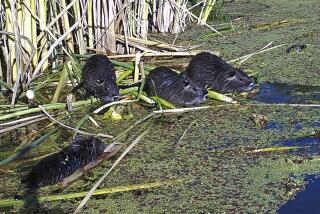Suffering bobcats, coyotes, owls spur Thousand Oaks neighborhood to rethink war on rats
- Share via
The sight was heartbreaking: a thin, mangy bobcat trembling against a brick wall separating the Thousand Oaks neighborhood of Dos Vientos from open space that is habitat for wildlife and popular among hikers.
The wildcat was too sick to move, even as passersby stepped closer one recent morning to snap photographs.
“It just stared at us,” Stephanie Marlin, 53, recalled, “with eyes that seemed to say, ‘Look what you guys did to me.’”
Join the conversation on Facebook >>
A few hours later, Marlin posted snapshots of the animal on Facebook. By day’s end, they were being used in an emotional fight across social media channels over the unintended collateral damage of the Dos Vientos Ranch Community Assn.’s annual $40,000 war on rats.
Images of dead and dying bobcats, mountain lions, coyotes and owls posted on Dos Vientos community message boards and chat threads have aroused outrage among residents in and around the Santa Monica Mountains National Recreation Area. They believe rodenticides are working their way up the food chain.
“The whole food chain is getting slammed,” said Bret Woolley, 51, a Dos Vientos resident and government contractor for the Navy. “Just last weekend, photos were posted of two bobcats and an owl suffering terribly. Others commented on seeing coyotes on the side of the road dying.”
Kathy O’Connor, spokeswoman for the association in southern Ventura County, was unavailable for comment. But in a response to critics posted online last Monday, she said the association was not responsible because its pest control service switched to a nontoxic method of eliminating rats in December.
That method tracks rodent movement by baiting boxes with a special additive that makes their droppings glow bright neon green under black light. If rodents are determined to be abundant in a given area, pest control technicians dispatch them with snap-traps.
Just recently, however, opponents of the pest control campaign discovered six boxes baited with anticoagulant rodenticide spaced roughly 100 feet apart along the backyard fencing of Dos Vientos homes.
Anticoagulants had been used until 2014, when California banned the sale to the public of so-called second-generation rat poison, which is more toxic than earlier versions and remains in a target species body at such high levels that other animals feeding on rat carcasses often also die.
But the law allows farms and licensed exterminators to continue using any of several varieties of second-generation anticoagulants, which induce death by internal bleeding.
In an interview, Chuck Cooley, president of Ventura Pest Control Co., which has contracted with Dos Vientos for 10 years, acknowledged that the toxic bait boxes may have been mistakenly left behind after his company switched to snap traps.
“My technicians spent many hours walking around out there to make sure that we removed every bait station with rodenticide in it,” he said. “Is it possible we missed a few? Possibly.”
Lisa Gunn found some of the baited boxes in question.
“None of these boxes are marked with a skull and crossbones, or any other image warning they contain powerful poison,” she said. “They do say ‘tamper proof,’ however, which is a joke. I easily pried one of them open with a screwdriver.”
Inside that box were six packets of a second-generation rodent killer that, according to its manufacturer, rats “find very palatable,” and lethal after a single feeding.
The consequences for wild animals “are captured in photos posted online for all the world to see,” she said. She said the message to the homeowners association is: “No more excuses. No more discussion. Just get rid of these things.”
National Park Service scientists for years have documented widespread exposure in carnivores to common household poisons in and around the Santa Monica Mountains National Recreation Area. During two decades of research in the region on carcasses and live animals, 88% of 140 bobcats, coyotes and mountain lions evaluated tested positive for one or more anticoagulant compounds.
In 2014, three bobcats were found dead at UC Santa Cruz, and Griffith Park’s well-known mountain lion, P-22, suffered from mange symptoms that biologists believe were due to exposure to first-generation anticoagulant rodenticide. Toxicological tests of liver samples taken from the carcass of a western gray squirrel discovered at Griffith Park a year ago found evidence of exposure to rodenticide.
Thousands of predators and birds of prey across the state are known to have died from internal bleeding from exposure to anticoagulants, shredding the social structures of these highly organized and intelligent creatures.
Among them was P-34, a once-photogenic mountain lion whose carcass was found by a runner in nearby Point Mugu State Park on Sept. 30. A necropsy at the California Animal Health and Food Safety Lab in San Bernardino determined it died of exposure to rat poisons.
“The insanity of it all is that in trying to wipe out rats they are killing the very animals that keep rat populations under control,” said Julie Schowitz, 53, who lives in nearby Newbury Park.
For Stephanie Marlin, there are personal emotional implications.
“I’ll never forget the look in that bobcat’s eyes,” she said. “It made me feel utterly helpless.”
Twitter: @LouisSahagun
ALSO
Mercury, DDT and other contaminants in fish are at a four-decade low
After recent ICE raids, sanctuary movement grows for immigrant here illegally
Warm temperatures, up to 70 mph winds expected in L.A., Ventura counties







